B0041VYHGW EBOK (84 page)
Authors: David Bordwell,Kristin Thompson

CONNECT TO THE BLOG
One common function of tracking shots is to follow actors in conversation, as we discuss in “Walk the talk.”
The mobile frame can move independently of the figures, too. Often the camera moves away from the characters to reveal something of significance to the narrative. A camera movement can point out an overlooked clue, a sign that comments on the action, an unnoticed shadow, or a clutching hand. The moving camera can establish a locale the characters will eventually enter. This is what happens at the start of Otto Preminger’s
Laura,
when the camera glides through Waldo Lydecker’s sitting room, establishing him as a man of wealth and artistic tastes, before revealing the detective MacPherson. Similarly, at the beginning of
Back to the Future,
the camera prowls through Doc’s empty house, hinting at his character and the narrative to come. In Jean Renoir’s
Crime of M. Lange,
the moving camera characterizes Lange by leaving him and panning around to survey his room
(
5.147
–
5.151
).
Lange is shown to be a fantasist, living in the world of Western lore he draws on for his cowboy stories.
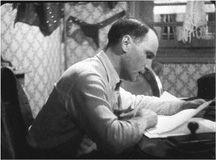
5.147 In
The Crime of M. Lange,
although the camera begins on Lange at work …
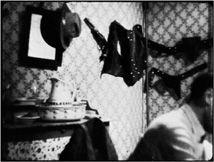
5.148 … it soon leaves him to show his cowboy pistols and hat …
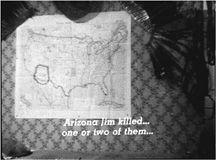
5.149 … keeps going to show a map with Arizona outlined …
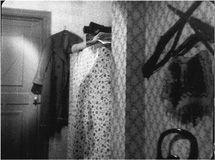
5.150 … pans past more guns …
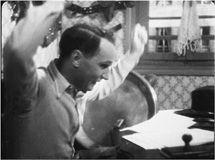
5.151 … before returning to the excited author writing his Western tales.
Whether dependent on figure movement or independent of it, the mobile frame can profoundly affect how we perceive the space within the frame and offscreen. Different sorts of camera movements create different treatments of space. In
Last Year at Marienbad,
Resnais often tracks into corridors and through doorways, turning a fashionable resort hotel into a maze. Alfred Hitchcock has produced some of the most famous single-camera movements in film history. One track-and-crane shot moves from a high-angle long shot of a ballroom over the heads of the dancers to an extreme close-up of a drummer’s blinking eyes (
Young and Innocent
). In
Vertigo,
an especially tricky combination track-
out
and zoom-
in
plastically distorts the shot’s perspective and conveys the protagonist’s dizziness. The device reappears in Spielberg’s
Jaws,
when Sheriff Brody at the beach suddenly realizes that the shark has attacked a child. Simultaneously tracking and zooming in opposite directions has become common in modern Hollywood filmmaking (what director Sam Raimi calls the “warp-o cam”). In films such as
The Red and the White,
Miklós Janscó specialized in lengthy camera movements that roam among groups of people moving across a plain. His shots use all of the resources of tracking, panning, craning, zooming, and racking focus to sculpt ever-changing spatial relations.
All of these examples illustrate various ways in which frame mobility affects our sense of space. Of any mobile framing, we can ask, How does it function to reveal or conceal offscreen space? Is the frame mobility dependent on figure movement or independent of it? What particular trajectory does the camera pursue? Such questions will best be answered by considering how spatial effects of the camera movement function with respect to the film’s overall form.
2.
The mobile frame and time
Frame mobility involves time as well as space, and filmmakers have realized that our sense of duration and rhythm is affected by the mobile frame. The importance of duration in camera movement, for example, can be sensed by comparing two Japanese directors, Yasujiro Ozu and Kenji Mizoguchi. Ozu prefers short camera movements in a single direction, as in
Early Summer
and
The Flavor of Green Tea over Rice.
Mizoguchi, alternatively, cultivates the leisurely, drawn-out tracking shot, often combining it with panning.
Since a camera movement consumes time on screen, it can create an arc of expectation and fulfillment. If the camera pans quickly from an event, we may be prompted to wonder what has happened. If the camera abruptly tracks back to show us something in the foreground that we had not expected, as in our earlier
Jezebel
example (
5.85
–
5.88
), we are taken by surprise. If the camera slowly moves in on a detail, gradually enlarging it but delaying the fulfillment of our expectations, the camera movement has contributed to suspense. In the pan shot across M. Lange’s study, Renoir makes us wonder why the camera strays from the main character, then answers the question by indicating Lange’s fascination with the American West. Later in this chapter, we shall examine how our expectations are manipulated over time in the opening camera movements of Welles’s
Touch of Evil.
The velocity of frame mobility is important, too. A zoom or a camera movement may be relatively slow or fast. Richard Lester’s
A Hard Day’s Night
and
Help!
started a fad in the 1960s for very fast zoom-ins and -outs. In comparison, one of the most impressive early camera movements, D. W. Griffith’s monumental crane shot in Belshazzar’s feast in
Intolerance,
gains majesty and suspense through its inexorably slow descent toward the immense Babylonian set (
4.12
).
Sometimes the speed of the mobile framing functions rhythmically. In Will Hindle’s
Pastorale d’été,
a gentle, bouncing beat is created by zooming in and slightly tilting up and down in time to Honegger’s music. Often musical films make use of the speed of camera movement to underline qualities of a song or dance. During the “Broadway Rhythm” number in
Singin’ in the Rain,
the camera cranes quickly back from Gene Kelly several times, and the speed of the movement is timed to accentuate the lyrics. Frame velocity can also create expressive qualities—a camera movement can be fluid, staccato, hesitant, and so forth. The entire plot of
Cloverfield
is presented as the video record of a monster’s attack on Manhattan. At many points, the operator whips the camera around to capture a shocking incident, and our anxiety is intensified by the sudden speed of the panning movement
(
5.152
,
5.153
).
In short, the duration and speed of the mobile frame can significantly control our perception of the shot over time.
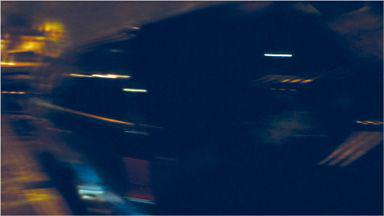
5.152
Cloverfield:
As the young partygoers run out into the street, their video camera records an explosion, and a whip pan to the right blurs the action.
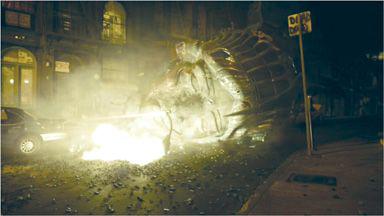
5.153 While the framing becomes fixed again, we see that the blurry movement was roughly following the head of the Statue of Liberty rolling down the street.